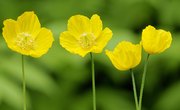Deserts occupy about one-fifth of the total earth’s surface, and the coldest deserts lie near the Arctic. Cold deserts have lots of snow, and it is rarely warm enough for plants to grow. Whatever plants grow there can do so in the summer and at the start of spring, when it is a little warmer than at any other time of the year. The plants in cold deserts are rarely concentrated in one area; instead, they tend to be scattered. The majority of plants there are deciduous and contain spiny foliage.
Rubber Rabbitbrush
Rubber rabbitbrush (Ericameria nauseosa) is a native cold desert plant of the Colorado Plateau. The plant is cold hardy and tolerates moisture and salt stress. A felt-like layer of trichomes coats the leaves and stems of the plant to keep the plant insulated. Rubber rabbibrush grows to a mature height of 1 to 4 feet with a round crown and a number of erect stems. The plants flower from June to September with 1/2-inch yellow green flowers. Rubber rabbitbrush adapts well to a wide range of soil types but prefers a moderately acidic or strong alkaline soil.
Tufted Saxifrage
Tufted saxifrage (Saxifraga caespitosa) is a small perennial plant of the cold desert. The plant has several erect flower stems and grows in thick mats. The foliage is thick and hairy, with the tips divided into three lobes. All varieties of saxifrage are cool weather plants with extensive underground root systems, which makes them well tolerant of the low temperatures in the cold deserts. Tufted saxifrage grows commonly on the rocky slopes and crevices in the deserts and appears abundantly in the Alaskan, Cascade and Olympic mountains.
Big Sagebrush
Big sagebrush (Artemisia tridentate) is one of the most common plants of the cold desert, thriving in elevations of 4,000 to 10,000 feet. The plant prefers dry plains and rocky areas with deep soil. Big sagebrush is a perennial shrub that achieves a mature height of 2 to 7 feet with a stout trunk and several upward growing side branches. The evergreen foliage is 1/4 to 2 inches long with three or five lobes at the tips. The plant blooms with thick clusters of small yellow flowers in late summer. The flowers contain tiny black seeds. Big sagebrush is an important winter browsing plant for a variety of wildlife species including sage grouse, small mammals, mule deer and domestic livestock.
References
About the Author
Irum Sarfaraz is a freelance writer with over 20 years of nonfiction writing experience in newspaper op-eds and magazine writing, book editing, translating and research writing. Sarfaraz is originally from Pakistan and has been published in both American and Pakistani newspapers and magazines. She holds a Bachelor of Arts in English literature, and diplomas in nonfiction writing.
